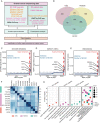KLF5 Promotes Tumor Progression and Parp Inhibitor Resistance in Ovarian Cancer
- PMID: 37702443
- PMCID: PMC10625120
- DOI: 10.1002/advs.202304638
KLF5 Promotes Tumor Progression and Parp Inhibitor Resistance in Ovarian Cancer
Abstract
One major characteristic of tumor cells is the aberrant activation of epigenetic regulatory elements, which remodel the tumor transcriptome and ultimately promote cancer progression and drug resistance. However, the oncogenic functions and mechanisms of ovarian cancer (OC) remain elusive. Here, super-enhancer (SE) regulatory elements that are aberrantly activated in OC are identified and it is found that SEs drive the relative specific expression of the transcription factor KLF5 in OC patients and poly(ADP-ribose) polymerase inhibitor (PARPi)-resistant patients. KLF5 expression is associated with poor outcomes in OC patients and can drive tumor progression in vitro and in vivo. Mechanistically, KLF5 forms a transcriptional complex with EHF and ELF3 and binds to the promoter region of RAD51 to enhance its transcription, strengthening the homologous recombination repair (HRR) pathway. Notably, the combination of suberoylanilide hydroxamic acid (SAHA) and olaparib significantly inhibits tumor growth and metastasis of PARPi-resistant OC cells with high KLF5. In conclusion, it is discovered that SEs-driven KLF5 is a key regulatory factor in OC progression and PARPi resistance; and potential therapeutic strategies for OC patients with PARPi resistance and high KLF5 are identified.
Keywords: KLF5; PARPi resistance; RAD51; homologous recombination repair; ovarian cancer; super-enhancer.
© 2023 The Authors. Advanced Science published by Wiley-VCH GmbH.
Conflict of interest statement
The authors declare no conflict of interest.
Figures








References
-
- Siegel R. L., Miller K. D., Wagle N. S., Jemal A., Ca‐Cancer J. Clin. 2023, 73, 17. - PubMed
-
- Macintyre G., Goranova T. E., De Silva D., Ennis D., Piskorz A. M., Eldridge M., Sie D., Lewsley L.‐A., Hanif A., Wilson C., Dowson S., Glasspool R. M., Lockley M., Brockbank E., Montes A., Walther A., Sundar S., Edmondson R., Hall G. D., Clamp A., Gourley C., Hall M., Fotopoulou C., Gabra H., Paul J., Supernat A., Millan D., Hoyle A., Bryson G., Nourse C., et al., Nat. Genet. 2018, 50, 1262. - PMC - PubMed
-
- Lheureux S., Gourley C., Vergote I., Oza A. M., Lancet 2019, 393, 1240. - PubMed
-
- Wiesner T., Lee W., Obenauf A. C., Ran L., Murali R., Zhang Q. F., Wong E. W. P., Hu W., Scott S. N., Shah R. H., Landa I., Button J., Lailler N., Sboner A., Gao D., Murphy D. A., Cao Z., Shukla S., Hollmann T. J., Wang L., Borsu L., Merghoub T., Schwartz G. K., Postow M. A., Ariyan C. E., Fagin J. A., Zheng D., Ladanyi M., Busam K. J., Berger M. F., Nature 2015, 526, 453. - PMC - PubMed
MeSH terms
Substances
Grants and funding
LinkOut - more resources
Full Text Sources
Medical
Research Materials
